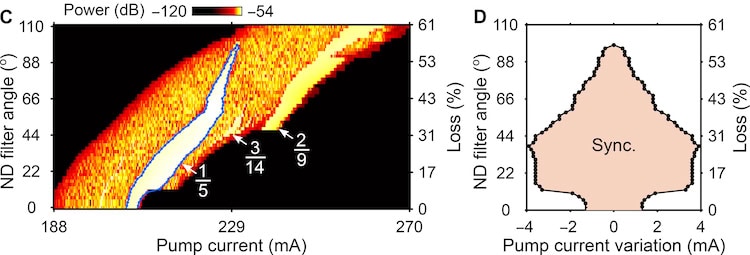
Abnormal versions of synchronization patterns known as “Arnold’s tongues” have been observed in a femtosecond fibre laser that generates oscillating light pulses. While these unconventional patterns had been theorized to exist in certain strongly-driven oscillatory systems, the new observations represent the first experimental confirmation.
Scientists have known about synchronization since 1665, when Christiaan Huygens observed that pendulums placed on a table eventually begin to sway in unison, coupled by vibrations within the table. It was not until the mid-20th century, however, that a Russian mathematician, Vladimir Arnold, discovered that plotting certain parameters of such coupled oscillating systems produces a series of tongue-like triangular shapes.
These shapes are now known as Arnold’s tongues, and they are an important indicator of synchronization. When the system’s parameters are in the tongue region, the system is synchronized. Otherwise, it is not.
Arnold’s tongues are found in all real-world synchronized systems, explains Junsong Peng, a physicist at East China Normal University. They have previously been studied in systems such as nanomechanical and biological resonators to which external driving frequencies are applied. More recently, they have been observed in the motion of two bound solitons (wave packets that maintain their shapes and sizes as they propagate) when they are subject to external forces.
Abnormal synchronization regions
In the new work, Peng, Sonia Boscolo of Aston University in the UK, Christophe Finot of the University of Burgundy in France, and colleagues studied Arnold’s tongue patterns in a laser that emits solitons. Lasers of this type possess two natural synchronization frequencies: the repetition frequency of the solitons (determined by the laser’s cavity length) and the frequency at which the energy of the soliton becomes self-modulating, or “breathing”.
In their experiments, which they describe in Science Advances, the researchers found that as they increased the driving force applied to this so-called breathing-soliton laser, the synchronization region first broadened, then narrowed. These changes produced Arnold’s tongues with very peculiar shapes. Instead of being triangle-like, they appeared as two regions shaped like leaves or rays.
Avoiding amplitude death
Although theoretical studies had previously predicted that Arnold’s-tongue patterns would deviate substantially from the norm as the driving force increased, Peng says that demonstrating this in a real system was not easy. The driving force required to access the anomalous regime is so strong that it can destroy fragile coherent pulsing states, leading to “amplitude death” in which all oscillations are completely suppressed.
In the breathing-soliton laser, however, the two frequencies synchronized without amplitude death even though the repetition frequency is about two orders of magnitude higher than the breathing frequency. “These lasers therefore open up a new frontier for studying synchronization phenomena,” Peng says.
To demonstrate the system’s potential, the researchers explored the effects of using an optical attenuator to modulate the laser’s dissipation while changing the laser’s pump current to modulate its gain. Having precise control over both parameters enabled them to identify “holes” within the ray-shaped tongue regions. These holes appear when the driving force exceeds a certain strength, and they represent quasi-periodic (unsynchronized) states inside the larger synchronized regions.
“The manifestation of holes is interesting not only for nonlinear science, it is also important for practical applications,” Peng explains. “This is because these holes, which have not been realized in experiments until now, can destabilize the synchronized system.”
Understanding when and under which conditions these holes appear, Peng adds, could help scientists ensure that oscillating systems operate more stably and reliably.
Extending synchronization to new regimes
The researchers also used simulations to produce a “map” of the synchronization regions. These simulations perfectly reproduced the complex synchronization structures they observed in their experiments, confirming the existence of the “hole” effect.
Despite these successes, however, Peng says it is “still quite challenging” to understand why such patterns appear. “We would like to do more investigations on this issue and get a better understanding of the dynamics at play,” he says.
The current work extends studies of synchronization into a regime where the synchronized region no longer exhibits a linear relationship with the coupling strength (as is the case for normal Arnold’s-tongue pattern), he adds. “This nonlinear relationship can generate even broader synchronization regions compared to the linear regime, making it highly significant for enhancing the stability of oscillating systems in practical applications,” he tells Physics World.
The post Abnormal ‘Arnold’s tongue’ patterns appear in a real oscillating system appeared first on Physics World.

